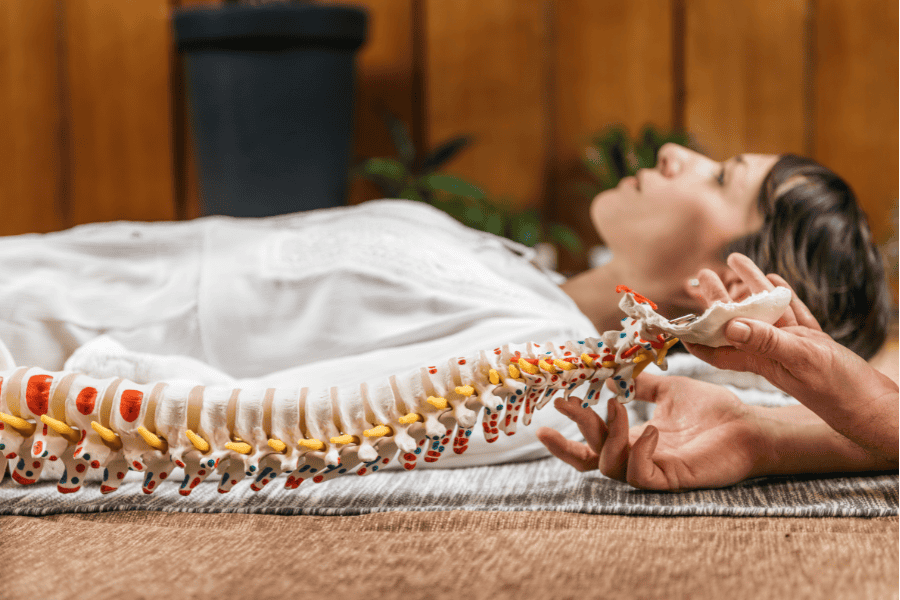A Look at the Science, Philosophy & Gentle Power of Nervous System Healing
What Is Spinal Flow Technique?
Spinal Flow Technique is a gentle, holistic modality designed to release blockages in the spine and nervous system, without the cracking, popping, or force often associated with chiropractic care.
Founded by Dr. Carli Axford, a former chiropractor, Spinal Flow uses light touch at 33 specific access points along the spine to stimulate what is known as the Spinal Wave, an energetic release that supports healing on physical, emotional, and chemical levels.
It’s not just about spinal alignment, it’s about restoring the flow of life through your nervous system.
How Spinal Flow Differs from Traditional Chiropractic
While both Spinal Flow and chiropractic care aim to improve nervous system function, their methods and philosophies are different.
Spinal Flow
Chiropractic Care
Gentle touch at access points
Works with energy, emotion, and tension patterns
Primarily physical/mechanical approach
The Science Behind Spinal Flow
Spinal Flow is grounded in key principles of neuroscience, neuroplasticity, and energy medicine:
- Neuroplasticity: Your nervous system can change and adapt. Spinal Flow encourages new, healthier patterns by calming the stress response.
- Spinal Blockages: Stressors (emotional, physical, or chemical) can create "static" in the nervous system. Spinal Flow clears these, allowing the body to heal.
- Innate Intelligence: Your body knows how to heal. Spinal Flow simply supports that process.
Practitioners assess your spine using the 7 Gateways and apply touch to the 33 access points, each with specific roles in activating the parasympathetic nervous system and releasing long-held tension.

What a Session Looks Like
During a typical Spinal Flow session:
- Your practitioner checks for tension or stagnation using the 7 Gateway assessment system.
You lie comfortably, fully clothed. - Light touch is applied to the access points, primarily at the sacrum and cranium.
- Your body begins to respond, often through small movements, breath shifts, or a visible Spinal Wave.
Most sessions last 15–20 minutes and leave people feeling lighter, calmer, and more at ease.
Common Benefits Clients Report
- Reduced physical pain or tension
- Improved sleep and digestion
- Emotional clarity or release
- Enhanced stress resilience
- Greater body awareness and calm
Spinal Flow is not a “treatment” for any specific disease, but many people find relief from things like headaches, digestive issues, fatigue, back pain, and even emotional overwhelm.
Frequently Asked Questions
Q: Is Spinal Flow safe for everyone?
Yes, it’s gentle and suitable for all ages, from newborns to seniors. There are no forceful adjustments involved.
Q: Can I do Spinal Flow while pregnant?
Absolutely. Many women find it incredibly grounding and helpful during pregnancy and postpartum recovery.
Q: How often should I come for sessions?
Some people benefit from weekly visits, while others come monthly or seasonally for nervous system support.
Q: Is it covered by insurance?
Some extended health plans may cover Spinal Flow under chiropractic or alternative therapy. Check with your provider.
Q: Can I combine it with other treatments?
Yes. Many clients combine Spinal Flow with massage, acupuncture, homeopathy, or energy work to support their healing journey.
More Than a Modality, A Return to Balance
Spinal Flow Technique isn’t about fixing you. It’s about reconnecting you to the part of yourself that already knows how to heal.
By clearing what’s blocking your body’s natural rhythm, you make space for peace, clarity, and deep physical restoration.
Gentle. Profound. Transformative.




